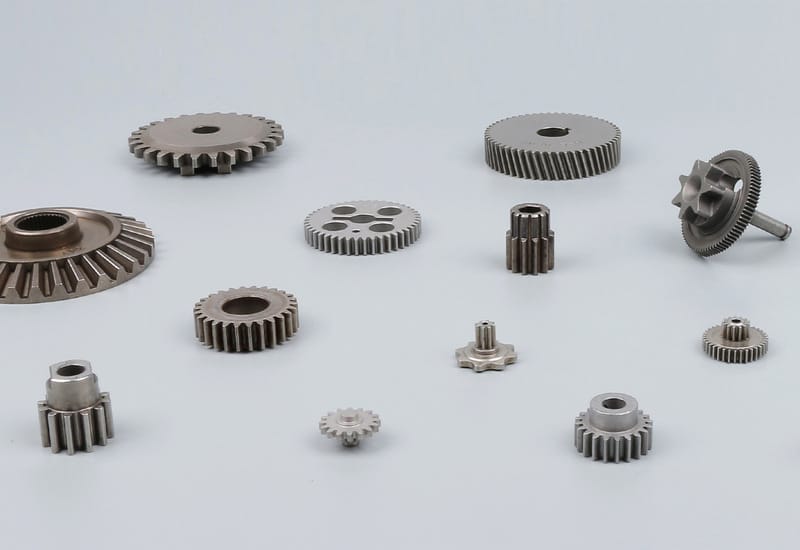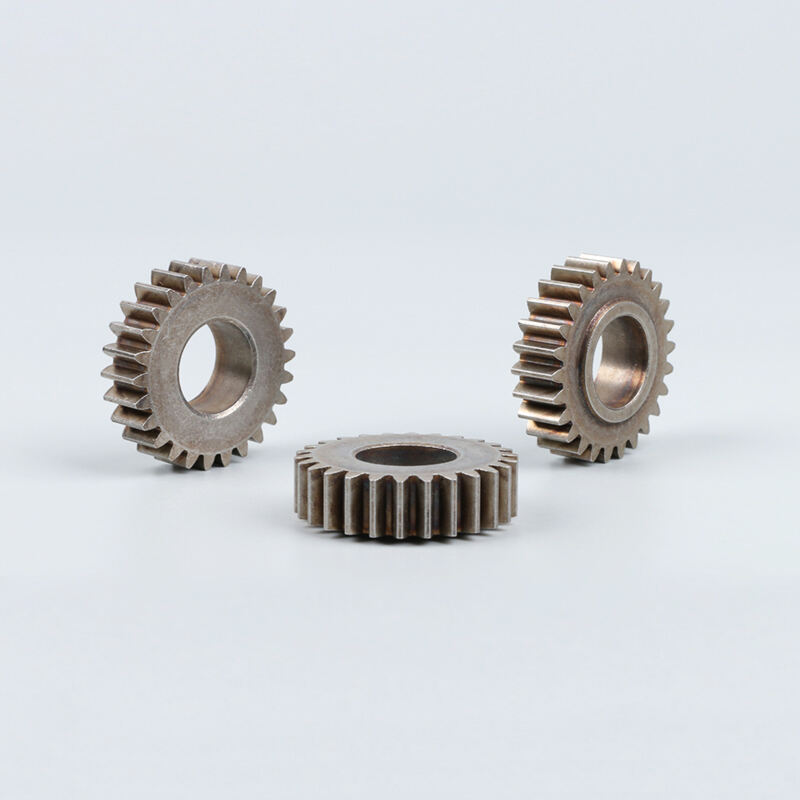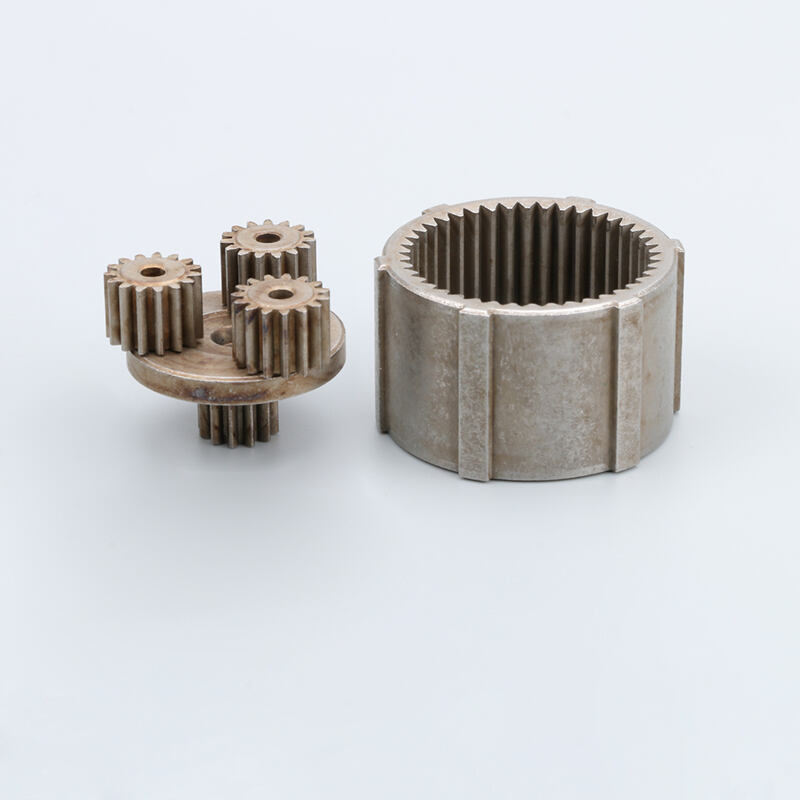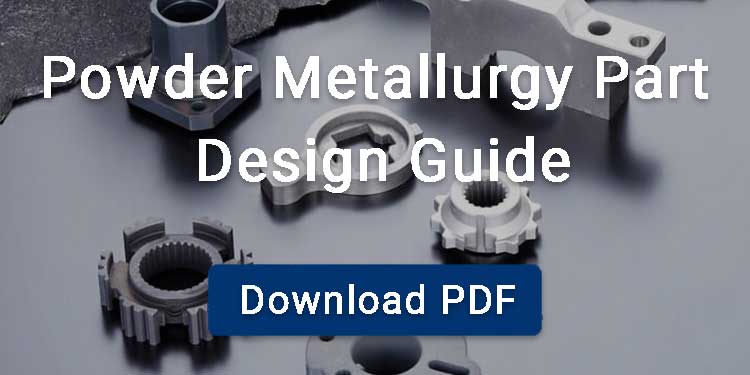Sintered gears, also referred to as powder metal gears, are manufactured by the powder metallurgy (PM) process. They have near-net-shape geometry and precise tooth profiles, which are important for efficient torque transmission in mechanical systems. Sintered gears are produced using iron-based alloys and other nickel or copper-based powder materials for the required strength and durability. These gears found their applications in various industries, including automotives, power tools, and industrial machinery. A key benefit of powder metal gears is their cost-effective production, which minimizes material waste and secondary machining compared to traditional forging or casting methods.

Contents
Sintered Gears Manufacturing Process
Powder Mixing
The process of sintered gear manufacturing begins by converting the metal into its powder form. This fine metal powder is obtained by any of these processes:
Atomization
Atomization is a widely used method where molten metal is disintegrated into fine droplets by a high-pressure gas or liquid jet. The resulting powder particles can range significantly in size, from 10 µm up to 500 µm.
- Gas atomization typically produces spherical particles in the 15 to 250 µm range.
- Water atomization often results in irregularly shaped particles with a median size of 50 to 150 µm.
Electrolysis
Metal powders produced by electrolysis generally fall within a particle size range of 25 to 200 µm. However, the particle size and morphology can be influenced by various electrolytic parameters, such as current density.
Reduction of Metal Ores
This process typically yields excellent powders. For carbonyl iron and nickel powders obtained through chemical decomposition, the particle size range is generally between 1 to 8 µm.
Compaction
During compaction process, a high-precision die of the desired gear geometry is filled with a powder mixture. the general compaction pressure is about 400-800 MPa. This step determines the final geometry of the gear. Any sort of imperfection here may lead to inconsistencies and structural weaknesses in the final component.
Sintering
Now the green compact is subjected to sintering process, where it is heated at high temperature below melting point in a sintering furnace with controlled atmosphere. For iron components, sintering temperatures can reach up to 1120 °C, while stainless steel parts require temperatures as high as 1250 °C. During sintering, adjacent powder particles fuse together, resulting to an increase in the density of the component.

Secondary Operations
In powder metallurgy (PM), secondary operations are post-sintering processes performed to improve the part’s dimensional accuracy, surface quality, and mechanical strength. The common secondary operations are:
Sizing
During sintering, the gear may undergo minor dimensional distortions, which is why it is subjected to sizing. Here, the sintered gear is placed back into a high-precision die and repressed under moderate pressure. This process slightly deforms the surface to achieve tighter tolerances and seal open porosity. Sizing can achieve tolerance levels of ±0.01 mm in precision applications.
Machining
For more intricate features, the sintered gear is further subjected to a machining process which includes: drilling, turning, milling, grinding, and honing of bores, faces, and gear teeth.
Surface treatment
Sintered gears are also subjected to surface treatment to improve wear resistance and corrosion protection. For surface treatment, a number of finishing methods are adopted depending upon the requirements, such as vibratory deburring, polishing, lapping, coating, and plating.
Heat treatment
Heat treatment is applied after sintering to achieve the desired combination of hardness, strength, and wear resistance. Treatments such as annealing, quenching, tempering, and carburizing may be used.
Powder Metal Materials for Sintered Gears
Pure Iron and Iron-Based Alloys
Pure iron and iron-based alloys, such as Fe–C (iron–carbon) steels and Fe–Cu–C alloys, are the most common and cost-effective materials used for sintered gear manufacturing. Manufacturers prefer these materials because they offer good mechanical strength and durability.
Stainless Steel and Alloyed steels
As stainless steel (316 and 304) is known for its resistance towards oxidation, preventing the component from corrosion. That is why it is used for manufacturing gears subjected to harsh conditions.
Copper Alloy
Copper and its alloys are used in the manufacturing of gears due to their high chemical resistance to oxidation, excellent thermal conductivity, and non-magnetic properties. Such gears are best suited for low-load applications exposed to corrosive or high-temperature environments. These alloys include:
Bronze
Bronze, an alloy primarily composed of copper (Cu) and tin (Sn), is one of the most reliable materials for producing sintered gears. This is because of its properties such as high strength, hardness, wear resistance, and corrosion resistance. Out of which it is considered ideal for applications requiring long-term durability and smooth operation.
Brass
It’s an alloy of Cu with Zn; the introduction of Zn in Cu reduces ductility and increases its strength. Sintered gear manufactured using these alloys are used in low-load environments, such as precision instruments or small mechanical devices.
Advantages of Sintered Gears
Tight Tolerances
One of the key advantages of manufacturing gear through sintering is the ability to achieve exceptional dimensional accuracy. Sintered gears can consistently maintain tolerances as tight as ±0.01 mm, ensuring precise meshing and reliable performance.
Quality Consistency
PM offers high repeatability as each gear is manufactured using the same die, maintaining consistency and precision. This ensures uniform quality across batches.
Cost Efficiency
When gears are manufactured through sintering it requires less machining, less material waste and often eliminates the need for secondary finishing processes compared to machined gears. This makes them cost effective although its equipment is expensive and requires an initial investment these tooling costs are offset by long-term production savings.
Minimal Waste
Gear manufacturing through sintering generates only about 3-5% material waste, compared to 50% in conventional machining.
Design Flexibility
PM allows the creation of complex geometries, including undercuts, internal features, and irregular profiles of gears.
Environmentally Friendly
Since sintering uses less energy, produces less waste, and offers the option of recycling metal powders. Out of which it is a more sustainable option compared to traditional machined gear.
Applications of Sintered Gears Across Industries
Automotive Applications
Powder metal gears find their applications extensively in automotive systems, including:
- Electric window motors
- Transmissions
- Camshafts, and crankshafts
These are considered ideal for electric powertrains and EV transmissions due to their lightweight and fatigue-resistant nature.
Power Tools
Sintered gears are also used in various power tools such as drills and screw drivers because of their lightweight and wear resistance. In these tools they deliver the necessary torque and speed control which helps the tool to maintain its efficiency while reducing noise and vibration.
Medical Industry
Sintered gears are trusted components in medical equipment and surgical tools. Their precision, non-reactive nature, and reliability are crucial in applications where patient safety and equipment accuracy are paramount.
Household Equipment
Sintered gears are commonly found in appliances like washing machines, vacuum cleaners, and kitchen mixers. These gears ensure quiet, reliable motion and consistent power transmission, contributing to the appliance’s overall performance and durability.
Industrial Machinery
These gears are essential in industrial machinery, including actuators, conveyors, and motion control systems, due to their precision and durability.
Why Choose BLUE Powder Metallurgy?
BLUE is a dedicated powder metallurgy manufacturer specializing in precision sintered gears.
Our product range includes spur gears, bevel gears, helical gears, and planetary gears.
You can explore a full range of standard parts in our SHOP, or contact us for customized gear solutions designed to your specifications.




